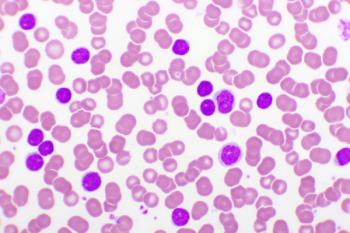
- July 2025
- Volume 31
- Issue Spec. No. 8
- Pages: SP481-SP482
Assay Finds Patients Who Will Benefit From Adjuvant Chemotherapy in Early-Stage NSCLC
Key Takeaways
- Biomarker testing identifies high-risk early-stage NSCLC patients for adjuvant chemotherapy, reducing recurrence risk by 78%.
- The AIM-HIGH study shows a 96% disease-free survival rate at 24 months with chemotherapy, compared to 79% without.
Molecular testing identifies high-risk early-stage NSCLC patients for adjuvant chemotherapy, significantly improving disease-free survival rates post-surgery.
Biomarker testing for early-stage patients with nonsquamous non–small cell lung cancer (NSCLC) allowed investigators to find and treat those patients who would benefit from chemotherapy after surgery, even though traditional guidelines would not suggest it.
The result? Patients who were treated were 78% less likely to see their disease return compared with a similar group not given chemotherapy.
Results of the AIM-HIGH study (NCT01817192), presented May 31, 2025, at the
David Spigel, MD, chief scientific officer at Sarah Cannon Research Institute, shared results from an international, multicenter, prospective randomized trial, which used a 14-gene molecular assay to select high-risk patients with stage IA-IIA NSCLC who would be candidates for adjuvant chemotherapy.
As Spigel explained in a press conference, “Adjuvant therapy, although used commonly in the treatment of non–small cell lung cancer, is not recommended for stage IA disease, and is often deferred in stages IB and stage II.”
Molecular testing, however, might reveal which patients have high-risk features beyond what can be seen in the tumor itself. The approach was so successful that at 24 months, disease-free survival (DFS) was 96% (95% CI, 0.92-1.00) for those who received adjuvant chemotherapy vs 79% (95% CI, 0.70-0.90) of patients in the observation group. Neither arm reached median DFS.
“This is the first prospective, randomized trial to show improvement in DFS with a molecular-risk discriminator in stage IA through stage IIA nonsquamous non–small cell lung cancer,” Spigel said during a press conference ahead of ASCO. He said that using this 14-gene assay to pinpoint who should have adjuvant therapy “may substantially reduce rates of early recurrence and death.”
Lung cancer causes
With lung cancer screening now recommended for at-risk patients in the US, more cases are being found when patients can be treated with surgery. Clinicians weigh a number of factors, such as cancer stage and tumor size, to decide who should have therapy before or after surgery to keep cancer from returning.
However, 5-year DFS rates remain at 65%, so methods to select other patients who might benefit from treatment after surgery were needed. This is where molecular testing can find changes in genes, proteins, and other markers that signify higher risk.
Spigel outlined the methodology for the study. Investigators used RiskReveal, a 14-gene expression profile, to identify patients at stage IA-IIA with nonsquamous NSCLC who night benefit from adjuvant therapy. Of 194 patients who were evaluable at the time of an interim analysis, 87 were randomized to receive therapy after surgery, while 107 were placed in an observation group. In both arms, 55% of the patients had stage IA disease. Demographics and tumor characteristics between the 2 groups were well balanced.
After a median follow-up of 19.6 months in the chemotherapy group and 19.0 months in the observation group, the HR for risk of disease recurrence or death in the chemotherapy arm was 0.22 (95% CI, 0.06-0.76; P = .0087).
Discussant Charu Agrawal, MD, Leslye M. Heisler Professor of Lung Cancer Excellence at Penn Medicine, concurred with Spigel’s assessment that there is a need to find patients who aren’t receiving adjuvant therapy, “yet we know that they are high risk.”
“These early interim results from this very promising, prospective randomized study will help us lay the foundation for precision therapy in early-stage non–small cell lung cancer,” she said, predicting that in addition to traditional assays, clinicians would have help from artificial intelligence solutions to better stratify patients.
“In the future, we may even be able to add personalized vaccines after we identify high-risk disease,” Agrawal said.
Reference
Spigel DR, Westeel V, Anderson IC, et al. An international, multicenter, prospective randomized trial of adjuvant chemotherapy for stage Ia-IIa non-small cell lung cancer identified as high-risk by a 14-gene molecular assay. J Clin Oncol. 2025;43(suppl 17). doi:10.1200/JCO.2025.43.17_suppl.LBA8027
Articles in this issue
Newsletter
Stay ahead of policy, cost, and value—subscribe to AJMC for expert insights at the intersection of clinical care and health economics.









































